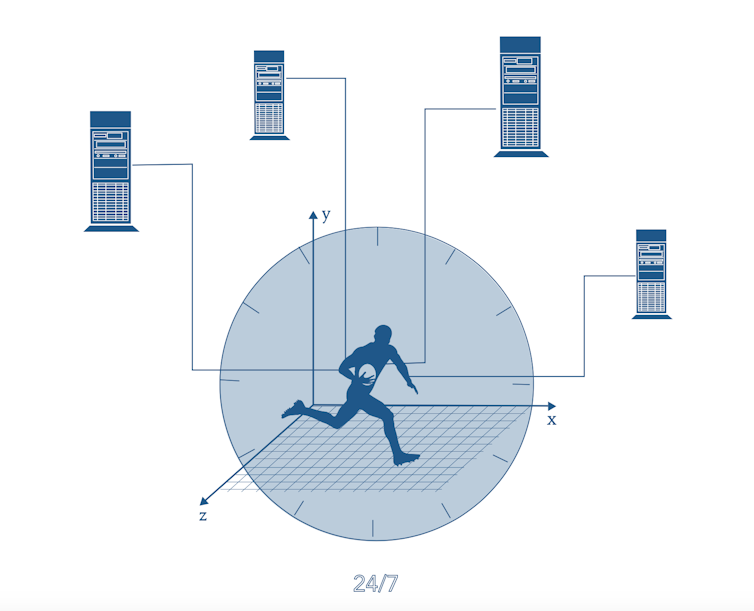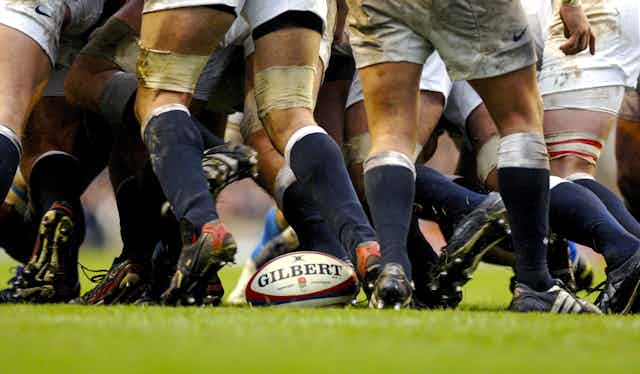Over the past decade, the top end of sport has become saturated in data. Some of this is visible — such as match statistics, maximum speeds and distances covered — but a tremendous amount is invisible.
Athletes are continuously being tracked. Details on their precise location, physiology, well-being, sleep, and more are recorded round the clock through an array of body-worn and observational technologies.
This information, most of which is personal and sensitive, is processed by a complex and opaque transnational system of commercial entities, including cloud providers, device manufacturers, analytics developers and athlete management systems.
Given the sheer scale and number of entities involved, few people know where this information goes. It’s rare for sports scientists and support staff to be able to account for it, and rarer still for sports governing bodies and athletes themselves.
The justification from technology vendors and sports clubs is that all this information is collected to improve performance and reduce injury risk to athletes.
But a number of people in the sports sector have started asking questions: is the data collection actually delivering athletes benefits? What are the costs? And what are the implications beyond the sector?

Assessing the state of play
To answer these questions, the Australian Academy of Science convened an expert working group over the past 18 months. The group, which we co-chaired, comprised a dozen experts from a range of fields including sports science, sports medicine, sports governance, artificial intelligence, law, policy, and social science.
The project drew on experience from a number of the working group’s members, who have worked for the past three decades in basketball, cricket, netball, rugby league, rugby union, football (soccer) and Australian rules football. We also interviewed 25 sports practitioners with experience working on professional sport codes in Australia, the United States and Europe.
Our findings, published today in a discussion paper, reveal the degree of personal and sensitive information collected from professional athletes is excessive, and often unjustified.
Our scientific review of the types of data being collected, and their use in professional sport, showed that much more information is collected than is demonstrably beneficial to athletes.
What’s more, how the information is being collected and used falls short of requirements laid out in Australian law. Excessive data collection that is neither demonstrably beneficial, nor lawful, has costs — not just for athletes, but for everyone who works in sport.
The great unpredictable drama of sport
Currently in professional sport, the approach to athlete data is “collect everything you can” and “save it in case it’s useful”. This is the sort of environment susceptible to snake oil salesmen peddling the promise of artificial intelligence and machine learning.
But as our expert group warns, there’s a crucial limit to any promise that if we can just gather enough data, we can leverage it to predict injury and performance.
We found what we can collect on athletes is almost always a second-order proxy of what we actually need in order to understand causal mechanisms of performance and injury.
Say we want to predict the risk of soft-tissue injury. Metrics routinely collected in professional sport such as total running time, distance covered, and repeat sprint efforts can be used to calculate macro measures of muscle work. Some sports might also make relative assessments of muscular strength deficits and asymmetries.
Ultimately, these are all low-resolution data inputs about athlete movement, attempting to reflect how hard the muscles are working. But this is a long way from describing the multi-scale complexity of human function. No amount of machine learning can bridge this gap.
Turning around unaccountable monitoring
Where do athletes figure in how sporting leagues and clubs handle the often intimately revealing information about them?
Current practices in professional sport are out of step with Australian legal requirements. Two major disconnects stand out. First, the category of “performance data” widely used in sport is not a legally recognised concept.
Rather, in law, the vast majority of what’s collected is actually health information, and requires much more robust protection and active athlete engagement.
Second, under Australian law, sporting organisations are limited to holding information that is “reasonably necessary” to their functions or activities. Australia’s leading privacy regulator has confirmed information “being entered in a database in case it might be needed in the future”, or being collected as part of “normal business practice”, simply does not satisfy this test.
Professional sport is a workplace. Few of us would be comfortable in a workplace where, rather than being judged on the outcome of our efforts, our every tiny movement was being unnecessarily observed and judged.
Remembering what works
Athletes risk having their livelihoods affected by data and systems that do not adequately reflect them, and that they can’t contest.
At the same time, increasingly invasive data collection risks replacing expert specialists — such as exercise physiologists, biomechanists and sports psychologists – with data analysts who lack domain expertise in the complexities of human function, especially in the small and highly specific populations who compete at the pinnacle of sport.
Our paper calls for a conversation about legal and ethical guardrails, and improvements in literacy and governance needed to ensure athletes have their rights protected and promoted. This is both in their own interest and in the public interest.
Change is coming
In a tangible sense, we are pleased that key players in the sector have been inspired by our work to tackle the challenge.
Player associations like the Rugby League Players Association are working with researchers to establish scientifically rigorous studies in specific areas to validate whether players’ intimate information can be linked to health outcomes. This is happening at a small scale before being considered for a wider rollout.
The Australian Institute of Sport, and associated state and territory entities, have initiated the award-winning Female Performance & Health Initiative. This has already led to restrained practices around menstrual tracking and other information collected on female athletes.
More broadly, the high performance system is implementing a long-term project, in partnership with the University of Western Australia, to establish a leading approach to athlete-centred data stewardship.
Just as Australia punches above its weight in the sporting arena, it has a historic opportunity to set forward-looking norms and standards around how it approaches athlete information. Let’s get ahead of the game.
Read more: Wearable tech at the Olympics: How athletes are using it to train to win

